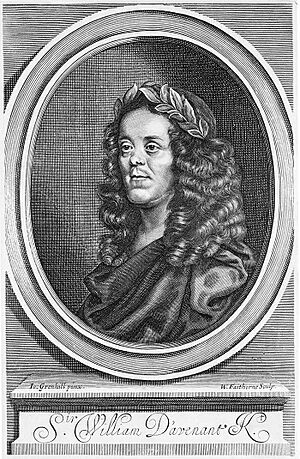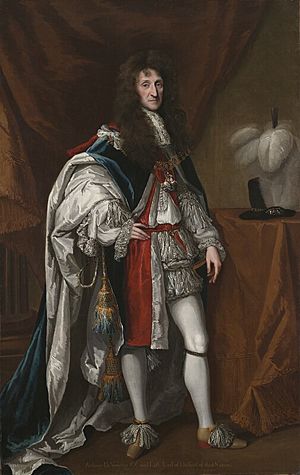Hester Davenport facts for kids
Hester Davenport (born March 23, 1642 – died November 16, 1717) was a famous actress in England. She worked with the Duke's Company, which was run by Sir William Davenant. She was one of the very first English actresses. Many people knew her as "that faire & famous Comoedian call'd Roxalana," as a writer named John Evelyn said after watching her perform in 1662. Her acting career ended when she married Aubrey de Vere, 20th Earl of Oxford in 1662 or 1663. They had a son in 1664. However, the Earl later left Hester and their son. In 1686, a court case showed that their marriage ceremony had not been real.
Hester's Acting Start
Around 1660, Hester Davenport joined the Duke's Company in London. She was one of a few actresses who worked there. The company was managed by Sir William Davenant. In 1661, Hester acted in Davenant's play The Wits. She also played important roles in other plays, like Gertrude in Hamlet and Evandra in Love and Honour.
People said she was "a charming, graceful creature and one that acted to perfection." In June 1661, she took on her most famous role: Roxalana. This was in a new version of Davenant's play The Siege of Rhodes. The play was updated to show off the talents of young actresses like Hester.
The writer Samuel Pepys was happy to see talented women like Hester acting. Before this, young men often played female roles. Pepys later wrote about missing 'Roxalana' when Hester stopped performing.
Hester and the Earl
The Earl of Oxford became very interested in Hester. He tried to win her over for nine months, but she turned him down. In February 1662, Samuel Pepys wrote in his Diary that Roxalana was no longer on stage. People thought she was living with the Earl by then.
Hester did not want to be the Earl's girlfriend. Instead, she agreed to marry him. They had a small wedding in the early 1660s. It took place in a shop in London. A man dressed as a clergyman performed the ceremony. Hester wore a beautiful white satin dress.
Hester and the Earl lived together as husband and wife. They lived first in Drury Lane and then in Covent Garden. Hester became pregnant, and their son, Aubrey de Vere, was born on April 17, 1664. He was baptized at St Paul's church. The Earl openly said he was the father. He also gave Hester money and helped with her debts. Some believed Hester Davenport was seen as the Countess of Oxford. In 1665, Samuel Pepys visited their home and noted it was very messy.
Later, the Earl married another woman, Diana Kirke, in January 1672. Hester Davenport took the Earl to court. In 1686, the Earl admitted that their wedding ceremony had been a trick. He said the man who performed the service was not a real clergyman. So, Hester could not prove she was legally married. The man who acted as the minister was likely one of the Earl's servants in disguise.
Even though Hester lost the case, she did not accept it. She kept using her married name. She also insisted their son was legitimate and tried to make him the heir to the Earl's title. The Earl's only son with his second wife died as a baby. Hester's son, Aubrey de Vere, lived longer than his father. However, he could not inherit the title. The title of Earl of Oxford, which was very old, ended when the 20th Earl died in 1703.
Many people felt sorry for Hester. They saw her as an innocent victim who had been tricked.
Hester's Final Years
After her time with the Earl, Hester Davenport remained single. She truly believed she was still married to him. When the Earl died in March 1703, she called herself the 'dowager Countess of Oxford.' However, on July 25, 1703, she married a merchant named Peter Hoet.
On June 4, 1708, her son, Aubrey de Vere, was buried at the Church of St Andrew in Holborn. He was buried as 'Earl of Oxford.' Hester's second husband, Peter Hoet, died in 1717. Hester Davenport died on November 16, 1717. On the day she died, she signed her will as 'Hester Oxford.' She left her belongings to friends, not her sister. Hester died just hours after saying again that she was the Earl of Oxford's rightful wife. She was buried on November 20 at St Anne's church in Soho, London.



